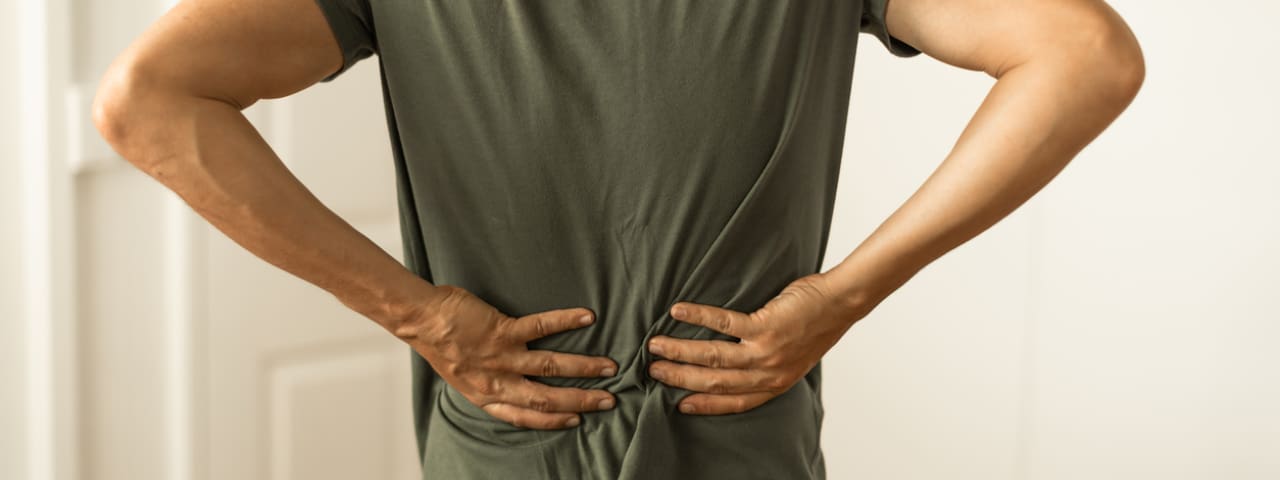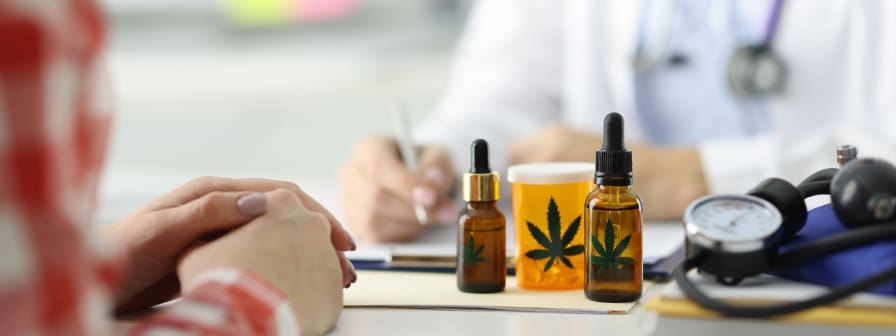How to dose cannabis topicals
6 min read



Of all of the different cannabis delivery methods, cannabis topicals stand out from the crowd. Rather than taken orally, they’re applied directly to the body to target specific “problem areas” affecting the skin or deep tissue. They’re easy to use, and once you find your perfect cannabis topical dosage, you can unlock a whole new way to experience the plant’s numerous therapeutic benefits.
Get Your Medical Card
Connect with a licensed physician online in minutes.
Larger purchase limits Access to higher potency strains Save up to 40% on product taxes Enhanced legal protection
What are cannabis topicals?
Cannabis topicals are marijuana-infused products that are applied to the skin. Typically, they contain cannabinoids like delta-9 tetrahydrocannabinol (THC) and cannabidiol (CBD), and many are formulated with other active ingredients frequently found in skin products, such as menthol, capsaicin, and arnica.
THC and CBD topicals can come in several different forms, including but not limited to:
- Balms
- Body butters
- Body sprays
- Creams
- Gels
- Lotions
- Oils
- Salves
- Transdermal patches
Applying a topical to the body allows the cannabis extract in the formula to penetrate the tissue of the skin, muscles, and joints, while the effects remain localized. Once absorbed, the cannabinoids in the cannabis plant interact with cannabinoid receptors in the epidermis before making their way into the deep tissue. That makes topicals ideal for anyone who wishes to treat a small area of the body, such as an area of inflamed skin or a sore muscle.
Because the THC doesn’t cross the blood-brain barrier, topicals are considered non-intoxicating, and unlikely to cause many of the side effects some people experience when taking cannabis, like drowsiness, anxiety, and impairment.
Some topical products have been shown to treat skin conditions, particularly of an inflammatory nature, like eczema and psoriasis. CBD, which is commonly found in cannabis topicals, could regulate sebum production to address acne. Overall, topicals may provide a reduction in inflammation and offer pain relief.
A major benefit of using topicals is how quickly they take effect and how long those effects can last. Again, because the product works locally, you may feel relief in as little as 15 minutes, and those effects may last up to six hours.
Factors that influence cannabis topical dosage
With cannabis topicals, you can enjoy a quick and easy approach to finding relief. However, without knowing how much to apply, you may miss out on the full benefits. There are a few factors to consider when deciding how much your cannabis topical dosage should be.
Tolerance
One factor to consider is individual tolerance. However, because topicals aren’t intoxicating, you don’t have to worry about your tolerance to cannabis’ psychoactive properties. Instead, you’ll want to consider how your endocannabinoid system responds to the effects of cannabis. Some individuals require higher doses of topical cannabinoids in to get the desired results, based on factors like cannabinoid receptor sensitivity and tissue density.
Symptom severity
Like with any medication, the severity of symptoms should be reflected in the dosage level. For example, a small dose may be sufficient for treating minor skin irritation. However, if you’re dealing with a serious sunburn a higher dose or amount of product may be needed.
Product potency
Topical formulas can vary in milligram strength. Naturally, the higher the milligram strength of the topical formula, the more potent the effects of each application will be, and the more a little can go a long way.
Product formulation
With some types of cannabis topical formulations, it may make sense to apply a smaller amount. An example would be body butter, which has a very thick consistency. Applying body butter excessively could leave behind a greasy residue.
Besides that, some topical formulas simply absorb through the skin tissue more easily than others. Water-based gels absorb quickly into the joint and muscle tissue, while thick, waxy products like balms and salves have a slower absorption rate due to their consistency.
How to dose different types of cannabis topicals
Because each type of THC topical has its own distinctive consistency, specific dosing directions may vary from one product type to the next.
Balms and salves
Most people who opt for cannabis balms and salves are hoping to address skin issues, as the thick consistency of these products helps the formula remain within the skin tissue. Apply enough to the affected area in a thin layer, and gently massage the formula into the skin.
Body butters, lotions, and creams
Either scoop or pump the desired amount into your hand, and massage it liberally into the affected area. The thinner the consistency, the easier it is to spread over a larger area. However, thicker-consistency products like body butters can be more moisturizing to the skin.
Gels
Water-based gel formulas are great at reaching the muscle and joint tissue quickly, without leaving behind a greasy residue. Apply the desired amount to the skin, and massage it well.
Oils
Because of their thin consistency, cannabis oils are great for covering large surface areas. They’re also ideal for massages. Pour a small amount into the hand and rub the palms together before massaging the product into the skin.
CBD oil can work particularly well for localized pain, and this product type is easy to find as well as apply.
Sprays
THC sprays are also excellent for covering large areas of the body and can be particularly helpful if you’re dealing with sunburn or widespread muscle and joint pain. Because sprays are usually water-based, they absorb quickly as an added benefit. Spray one or two pumps onto the affected area, and allow it to dry.
Transdermal patches
Transdermal patches should be applied to the affected area according to the directions on the product’s label.
General guidelines for dosing cannabis topicals
You should always do a patch test when trying a new skincare product, and wait to see how the formula affects the skin before applying it to the larger affected area. This way, you can be sure that your skin doesn’t react negatively to an ingredient in the product, such as an essential oil used to scent the topical.
While it’s true that most cannabis-infused topicals will not cause you to feel any intoxicating effects, using higher doses than you need could unnecessarily increase your topical tolerance. Besides that, using an excessive amount of product with each application could be a waste of money.
Following the label’s instructions
Thankfully, most topicals come with clear instructions on their labels, which take into consideration their milligram strength, formulation, and product consistency. It’s always best to follow these instructions and increase your dosage only as needed and tolerated to avoid wasting product.
Ask your healthcare provider
If you’re using a cannabis topical for a more severe condition like neuropathy or post-injury inflammation, your healthcare provider may suggest using a higher dose.
Safety tips
Although you may not be at risk of feeling psychoactive effects, safety considerations remain when dosing cannabis topicals. You should always read the label of any topical you purchase to ensure that the ingredients are safe and to avoid any ingredients you may be allergic or intolerant to.
You should also look into potential interactions between medications or substances you regularly use with cannabis topicals. Even using pure CBD products has been shown to cause interactions with certain medications, with some experts suggesting that using CBD products should necessitate an alteration in the dosage of these medicines.
Fortunately, the risk of a negative interaction is likely much lower with topicals because of how they’re metabolized. If you remain unsure as to how cannabis-infused topicals might interact with any medications you are on, speak to your healthcare provider.
And even though topicals likely will not cause you to feel high, you should always leave them out of reach from pets. Cannabis is toxic to cats and dogs, regardless of its form.
With the right dosage, cannabis topicals can offer fast, targeted relief
With a little trial and error, you can find the perfect cannabis topical dosage for your needs, and experience the therapeutic benefits of marijuana on a whole new level. For more personalized help finding the right cannabis topical dose for you, and to learn more about topicals overall, consider making an appointment with Leafwell.
Frequently asked questions
Can I overdose on a cannabis topical?
The good news is that cannabis topicals, like all cannabis products, are nontoxic. However, some topicals are infused with certain herbal or botanical extracts which may be harmful if applied in high concentrations. Please read the product label to ensure you’re using it safely.
What’s the best THC topical dosage for joint pain?
If you wish to use a THC topical for joint pain, ask your healthcare provider about the dosage that’s right for you. A licensed healthcare professional can consider your symptoms and medical history to help you make the best decision.
Will a THC topical or CBD topical make me feel sleepy?
It’s unlikely that cannabis topicals will cause drowsiness. The effects of topical products typically stay local to the area of application.
Get Your Medical Card
Connect with a licensed physician online in minutes.
Larger purchase limits Access to higher potency strains Save up to 40% on product taxes Enhanced legal protection
Resources
- TRP Channel Cannabinoid Receptors in Skin Sensation, Homeostasis, and Inflammation: https://pmc.ncbi.nlm.nih.gov/articles/PMC4240254/
- Topical cannabidiol (CBD) in skin pathology – A comprehensive review and prospects for new therapeutic opportunities: https://pmc.ncbi.nlm.nih.gov/articles/PMC9210160/
- Cannabidiol exerts sebostatic and antiinflammatory effects on human sebocytes: https://pmc.ncbi.nlm.nih.gov/articles/PMC4151231/
- The Cannabinoid CB2 Receptor as a Target for Inflammation-Dependent Neurodegeneration: https://pmc.ncbi.nlm.nih.gov/articles/PMC2435344/
- Cannabidiol Interactions with Medications, Illicit Substances, and Alcohol: a Comprehensive Review: https://pmc.ncbi.nlm.nih.gov/articles/PMC8298645/


